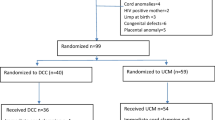Abstract
Purpose
We aimed to clarify whether the short-term adverse neonatal outcomes associated with epidural analgesia are due to the epidural analgesia itself or to the instrumental delivery.
Methods
A retrospective case–control study was conducted to evaluate the relationship between epidural analgesia, labor length, and perinatal outcomes. A total of 350 pregnant women at term who delivered under epidural analgesia (cases) were compared with 1400 patients without epidural analgesia (controls).
Results
Vacuum extraction (6.5 vs. 2.9 %) and cesarean section (19.9 vs. 11.1 %) were more frequently performed in the cases than controls (p < 0.001). Using a Kaplan–Meier algorithm, it was determined that the mean lengths of the 1st and 2nd stages of labor and the overall durations of labor and delivery were significantly longer in cases compared with controls. A Cox regression analysis showed that the longer labor remained even after adjustment for parity. The neonatal variables stratified by mode of delivery were not different in cases and controls, except for a slightly lower umbilical arterial pH in spontaneous delivery for the cases group. However, the Apgar scores and umbilical arterial pH were significantly lower in the neonates delivered by vacuum extraction compared with those in the neonates delivered by spontaneous delivery or cesarean section, regardless of whether epidural analgesia was performed. A multivariable analysis showed that vacuum extraction much more consistently affected the arterial pH than the analgesia itself (the β coefficients were −0.036 for epidural analgesia vs. −0.050 for vacuum extraction).
Conclusion
Epidural analgesia was associated with slowly progressing labor, thus resulting in an increased rate of instrumental delivery. This instrumental delivery appears to adversely affect the neonatal outcomes more strongly than the analgesia itself.

Similar content being viewed by others
References
Halpern SH, Leighton BL, Ohlsson A, Barrett JF, Rice A. Effect of epidural vs parenteral opioid analgesia on the progress of labor: a meta-analysis. JAMA. 1998;280:2105–10.
Leighton BL, Halpern SH. The effects of epidural analgesia on labor, maternal, and neonatal outcomes: a systematic review. Am J Obstet Gynecol. 2002;186:S69–77.
Reynolds F. The effects of maternal labour analgesia on the fetus. Best Pract Res. 2009;24:289–302.
Westgren M, Lindahl SG, Norden NE. Maternal and fetal endocrine stress response at vaginal delivery with and without an epidural block. J Perinat Med. 1986;14:235–41.
Shnider SM, Abboud TK, Artal R, Henriksen EH, Stefani SJ, Levinson G. Maternal catecholamines decrease during labor after lumbar epidural anesthesia. Am J Obstet Gynecol. 1983;147:13–5.
Deckardt R, Fembacher PM, Schneider KT, Graeff H. Maternal arterial oxygen saturation during labor and delivery: pain-dependent alterations and effects on the newborn. Obstet Gynecol. 1987;70:21–5.
Arfeen Z, Armstrong PJ, Whitfield A. The effects of Entonox and epidural analgesia on arterial oxygen saturation of women in labour. Anaesthesia. 1994;49:32–4.
Griffin RP, Reynolds F. Maternal hypoxaemia during labour and delivery: the influence of analgesia and effect on neonatal outcome. Anaesthesia. 1995;50:151–6.
Reynolds F. Labour analgesia and the baby: good news is no news. Int J Obstet Anesth. 2011;20:38–50.
Kjaergaard H, Olsen J, Ottesen B, Nyberg P, Dykes AK. Obstetric risk indicators for labour dystocia in nulliparous women: a multi-centre cohort study. BMC Pregnancy Childbirth. 2008;8:45.
Sharma SK, McIntire DD, Wiley J, Leveno KJ. Labor analgesia and cesarean delivery: an individual patient meta-analysis of nulliparous women. Anesthesiology. 2004;100:142–8 (discussion 6A).
Liu EH, Sia AT. Rates of caesarean section and instrumental vaginal delivery in nulliparous women after low concentration epidural infusions or opioid analgesia: systematic review. BMJ. 2004;328:1410.
Lieberman E, Davidson K, Lee-Parritz A, Shearer E. Changes in fetal position during labor and their association with epidural analgesia. Obstet Gynecol. 2005;105:974–82.
Shields SG, Ratcliffe SD, Fontaine P, Leeman L. Dystocia in nulliparous women. Am Fam Physician. 2007;75:1671–8.
Leighton BL, Halpern SH, Wilson DB. Lumbar sympathetic blocks speed early and second stage induced labor in nulliparous women. Anesthesiology. 1999;90:1039–46.
Wong CA, Scavone BM, Peaceman AM, McCarthy RJ, Sullivan JT, Diaz NT, Yaghmour E, Marcus RJ, Sherwani SS, Sproviero MT, Yilmaz M, Patel R, Robles C, Grouper S. The risk of cesarean delivery with neuraxial analgesia given early versus late in labor. N Engl J Med. 2005;352:655–65.
Benedetto C, Marozio L, Prandi G, Roccia A, Blefari S, Fabris C. Short-term maternal and neonatal outcomes by mode of delivery. A case-controlled study. Eur J Obstet Gynecol Reprod Biol. 2007;135:35–40.
Tracy SK, Sullivan E, Wang YA, Black D, Tracy M. Birth outcomes associated with interventions in labour amongst low risk women: a population-based study. Women Birth. 2007;20:41–8.
Caliskan E, Ozdamar D, Doger E, Cakiroglu Y, Kus A, Corakci A. Prospective case control comparison of fetal intrapartum oxygen saturations during epidural analgesia. Int J Obstet Anesth. 2010;19:77–81.
Reynolds F, Sharma SK, Seed PT. Analgesia in labour and fetal acid–base balance: a meta-analysis comparing epidural with systemic opioid analgesia. BJOG. 2002;109:1344–53.
Porter J, Bonello E, Reynolds F. Effect of epidural fentanyl on neonatal respiration. Anesthesiology. 1998;89:79–85.
Fernando R, Bonello E, Gill P, Urquhart J, Reynolds F, Morgan B. Neonatal welfare and placental transfer of fentanyl and bupivacaine during ambulatory combined spinal epidural analgesia for labour. Anaesthesia. 1997;52:517–24.
Krishna BR, Zakowski MI, Grant GJ. Sufentanil transfer in the human placenta during in vitro perfusion. Can J Anaesth. 1997;44:996–1001.
Acknowledgments
We wish to thank Dr. Dianella Ravagli and Dr. Alberto Bartolini for their excellent support in collecting subjects.
Conflict of interest
There are no conflicts of interest to disclose.
Author information
Authors and Affiliations
Corresponding author
About this article
Cite this article
Hasegawa, J., Farina, A., Turchi, G. et al. Effects of epidural analgesia on labor length, instrumental delivery, and neonatal short-term outcome. J Anesth 27, 43–47 (2013). https://doi.org/10.1007/s00540-012-1480-9
Received:
Accepted:
Published:
Issue Date:
DOI: https://doi.org/10.1007/s00540-012-1480-9




